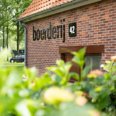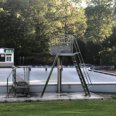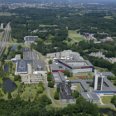The Hogekamp square has been sustainably renovated. The landscape has been redesigned, matching the new function of the Hogekamp building. This new landscape also suits the requirements of the students and the university: the campus is a place to study and meet.
Several highlights can be found here. Numerous durable concrete tiles connect various walking paths on the square. The gardens serve as habitat for insects, so they are richly planted with 8,850 m2 of perennials and 130 new trees. The new vegetation is good for biodiversity: bees in particular thrive here. Space has been left in between the tiles on the square to ensure water infiltration. Concrete culverts underneath the surface drain the water to the adjacent pond and are connected to the Waterlab.
One highlight stands out the most: the transparently designed water purification lab, or Waterlab. This lab is used by researchers from the Faculty of Science and Technology, who are researching water purification using membranes, to test various membrane techniques in practice. Hogekamp Square is a suitable place for the Waterlab: rainwater is already being collected, stored and drained into the adjacent Vrijhof pond. A purifying reedbed filter has been installed next to this pond. These plants remove impurities from the rainwater.
After the sustainable membrane purification, a technique developed by UT, the water has almost the same quality as drinking water and is then suitable for watering the sports fields on campus during the summer months. This way, we avoid using tap water for that purpose.
The adjacent terrace and car park were made using cementless concrete paving stones. The cement production industry is a very CO2-intensive industry and accounts for 8-10% of contribution to CO2-emissions worldwide. By building with these cementless stones, UT saved up to 29-ton CO2.





